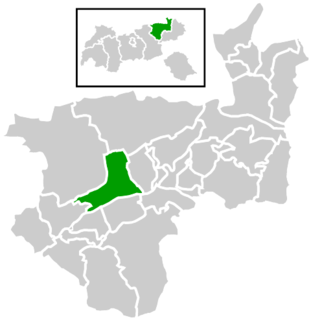Eching | ||
|---|---|---|
 Church of Saint Andrew | ||
| ||
| Coordinates: 48°18′N11°37′E / 48.300°N 11.617°E Coordinates: 48°18′N11°37′E / 48.300°N 11.617°E | ||
| Country | Germany | |
| State | Bavaria | |
| Admin. region | Oberbayern | |
| District | Freising | |
| Government | ||
| • Mayor | Sebastian Thaler (Ind.) | |
| Area | ||
| • Total | 37.83 km2 (14.61 sq mi) | |
| Elevation | 469 m (1,539 ft) | |
| Population (2017-12-31) [1] | ||
| • Total | 13,856 | |
| • Density | 370/km2 (950/sq mi) | |
| Time zone | CET/CEST (UTC+1/+2) | |
| Postal codes | 85386, 85379 | |
| Dialling codes | 089, 08165, 08133 | |
| Vehicle registration | FS | |
| Website | www.eching.de | |
Eching is a municipality in the district of Freising, in Upper Bavaria, Germany.

Municipalities are the lowest level of official territorial division in Germany. This is most commonly the third level of territorial division, ranking after the Land (state) and Kreis (district). The Gemeinde which is one level lower in those states also includes Regierungsbezirke as an intermediate territorial division. The Gemeinde is one level higher if it is not part of a Samtgemeinde. Only 10 municipalities in Germany have fifth level administrative subdivisions and all of them are in Bavaria. The highest degree of autonomy may be found in the Gemeinden which are not part of a Kreis. These Gemeinden are referred to as Kreisfreie Städte or Stadtkreise, sometimes translated as having "city status". This can be the case even for small municipalities. However, many smaller municipalities have lost this city status in various administrative reforms in the last 40 years when they were incorporated into a Kreis. In some states they retained a higher measure of autonomy than the other municipalities of the Kreis. Municipalities titled Stadt are urban municipalities while those titled Gemeinde are classified as rural municipalities.

Freising is a Landkreis (district) in Bavaria, Germany. Following a recent ranking of the German magazine Focus-Money comparing all German districts it is number one concerning economic growth abilities. It is bounded by the districts of Kelheim, Landshut, Erding, Munich, Dachau and Pfaffenhofen. The district is located north of the Munich metropolitan area. The Isar and Amper rivers run in parallel from southwest to northeast. North of the rivers there is the Hallertau, a hilly region mainly used for hop growing.

Upper Bavaria is one of the seven administrative districts of Bavaria, Germany.




























